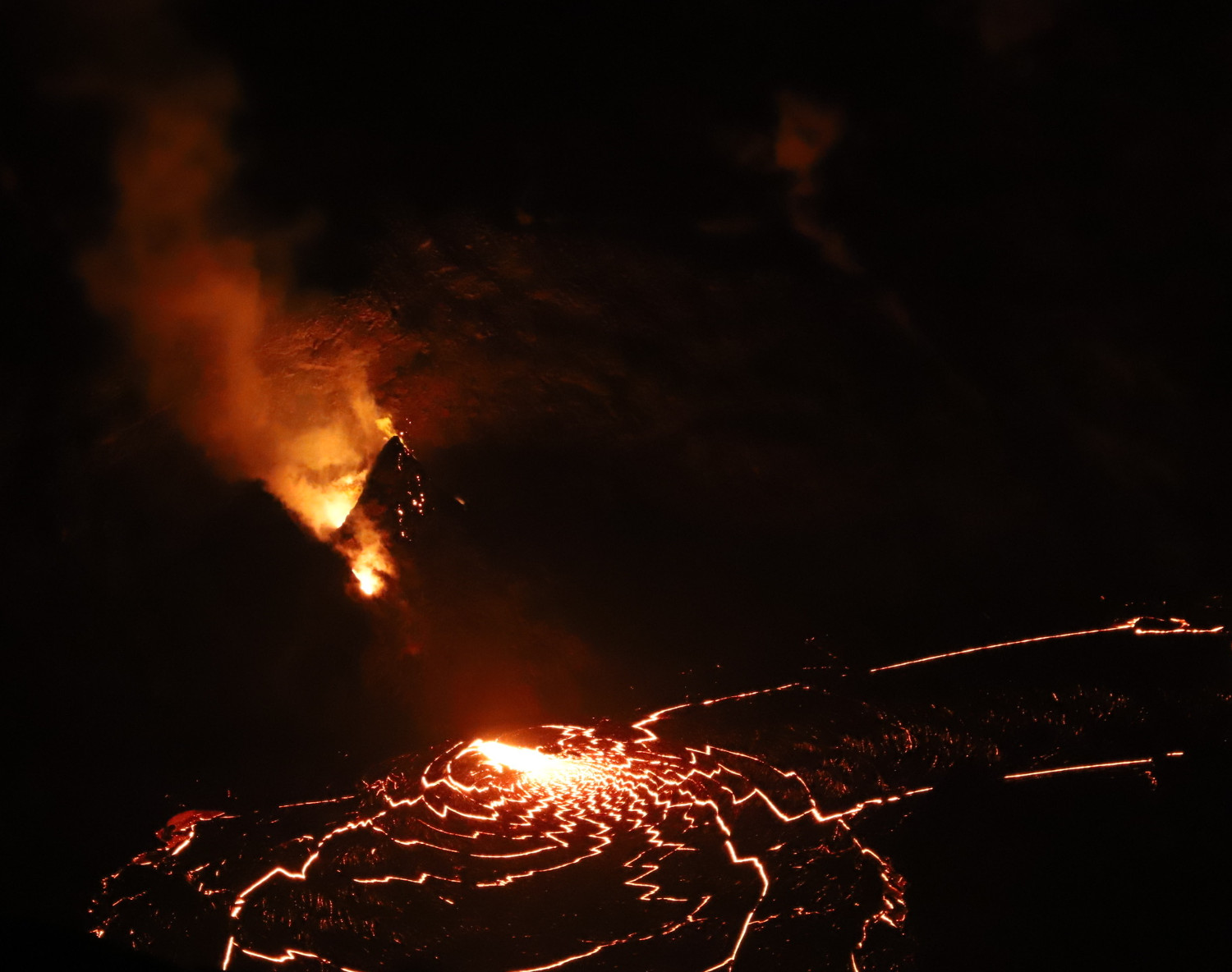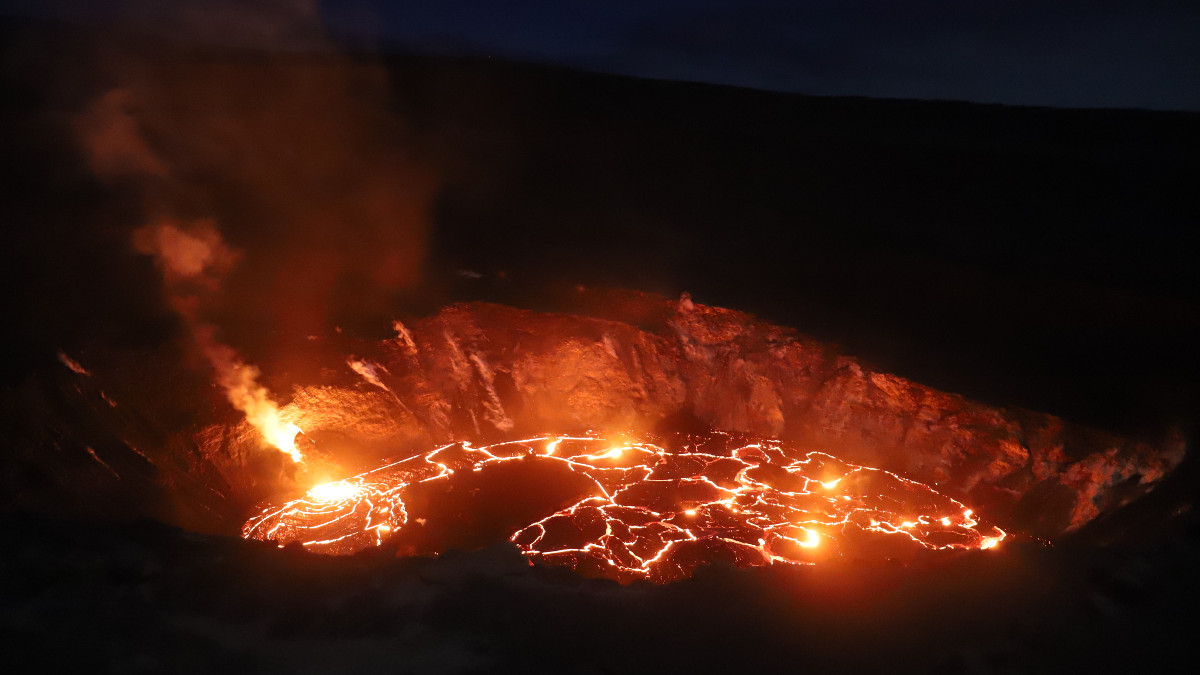
The west vent within Halema‘uma‘u crater continues to erupt with no significant changes over the last several days. Glowing is seen from skylights above the vent and occasional spatter, visible in the photo, is ejected from these skylights. The weak spatter has slowly been building a cone at the vents. The channel of lava, which crusted over several days ago, continues to supply lava to the lake. The bright upwelling site adjacent to the vent is where lava is entering the lake through the crusted channel. USGS photo taken by H. Dietterich on January 2.
(BIVN) – The new eruption of Kīlauea continues at the summit, and the volcano alert level remains at the WATCH / ORANGE alert level. From this morning’s USGS Hawaiian Volcano Observatory update:
Activity Summary: Lava activity is confined to Halemaʻumaʻu with lava erupting from vents on the northwest side of the crater. Early this morning (Jan. 2), the lava lake was 189 m (620 ft) deep with a narrow black ledge around it. SO2 emission rates were still elevated.
Summit Observations: Sulfur dioxide emission rate measurements made Thursday (Dec. 31) were about 6300 t/d and in the range 3,000-6,500 t/d since Sunday (Dec. 27)–the same range of values that was common for the pre-2018 lava lake. Summit tiltmeters recorded weak deflationary tilt over the past day. Seismicity remained elevated but stable, with steady elevated tremor and a few minor earthquakes.
East Rift Zone Observations: Geodetic monitors indicate that the upper portion of the East Rift Zone (between the summit and Puʻu ʻŌʻō) contracted while the summit deflated. There is no seismic or deformation data to indicate that magma is moving into either of Kīlauea’s rift zones.
Halemaʻumaʻu lava lake Observations: The west vents spattered while erupting lava flowed through crusted-over channels into a lava lake within Halemaʻumaʻu crater.
The lava lake was 189 m (620 ft) deep early this morning (Jan. 2). The most recent thermal map (Dec. 30) provided the lake dimensions as 800 by 530 m (875 by 580 yds) for a total area of 33 ha (82 acres). The narrow (10-30 m or 11-33 yd) ledge around the lake was about 1-2 m (1-2 yds) above the active lake surface.
Over the past day, the main island of cooler, solidified lava floating in the lava lake drifted to the west before settling in front of the west lava source filling the lake around midnight, while the other 10 or so small islands remained relatively stationary around the east end of the lake. The main island measured about 250 m (820 ft) in length, 135 m (440 ft) in width, and about 3 ha (7 acres) in area based on the Dec. 30 thermal map. Measurements Friday afternoon (Jan. 1) showed that the island surface was about 6 m (20 ft) above the lake surface.
Near-real time webcam views of the lava lake can be found here.
Hazard Analysis: High levels of volcanic gas, rockfalls, explosions, and volcanic glass particles are the primary hazards of concern regarding this new activity at Kīlauea’s summit. Large amounts of volcanic gas—primarily water vapor (H2O), carbon dioxide (CO2), and sulfur dioxide (SO2)—are continuously released during eruptions of Kīlauea Volcano. As SO2 is released from the summit during this new eruption, it will react in the atmosphere with oxygen, sunlight, moisture, and other gases and particles, and within hours to days, convert to fine particles. The particles scatter sunlight and cause the visible haze that has been observed downwind of Kīlauea, known as vog (volcanic smog), during previous summit eruptions. Vog creates the potential for airborne health hazards to residents and visitors, damages agricultural crops and other plants, and affects livestock operations. Rockfalls and minor explosions, such as the ones that occurred during the 2008–2018 lava lake eruption at Kīlauea summit, may occur suddenly and without warning. This underscores the extremely hazardous nature of Kīlauea caldera rim surrounding Halemaʻumaʻu crater, an area that has been closed to the public since late 2007. Pele’s hair and other lightweight volcanic glass fragments from the lava fountains within Halemaʻumaʻu will fall downwind of the fissure vents and lava lake, dusting the ground within a few hundred meters (yards) of the vent. High winds may waft lighter particles to greater distances. Residents are urged to minimize exposure to these volcanic particles, which can cause skin and eye irritation similar to volcanic ash.
Vog information can be found at vog.ivhhn.org.
Please see this Hawaii Volcanoes National Park Press Release “How to Safely View the New Eruption in Hawaiʻi Volcanoes National Park”.
The Hawaiian Volcano Observatory (HVO) continues to closely monitor Kīlauea’s seismicity, deformation, and gas emissions for any sign of reactivation, and maintains visual surveillance of the summit and the East Rift Zone. HVO will continue to issue daily updates and additional messages as needed.


by Big Island Video News8:51 am
on at
STORY SUMMARY
HAWAIʻI VOLCANOES NATIONAL PARK - The west vent in Halema‘uma‘u remains active at Kīlauea. Gas emissions and seismic activity at the summit remain elevated, scientists say.